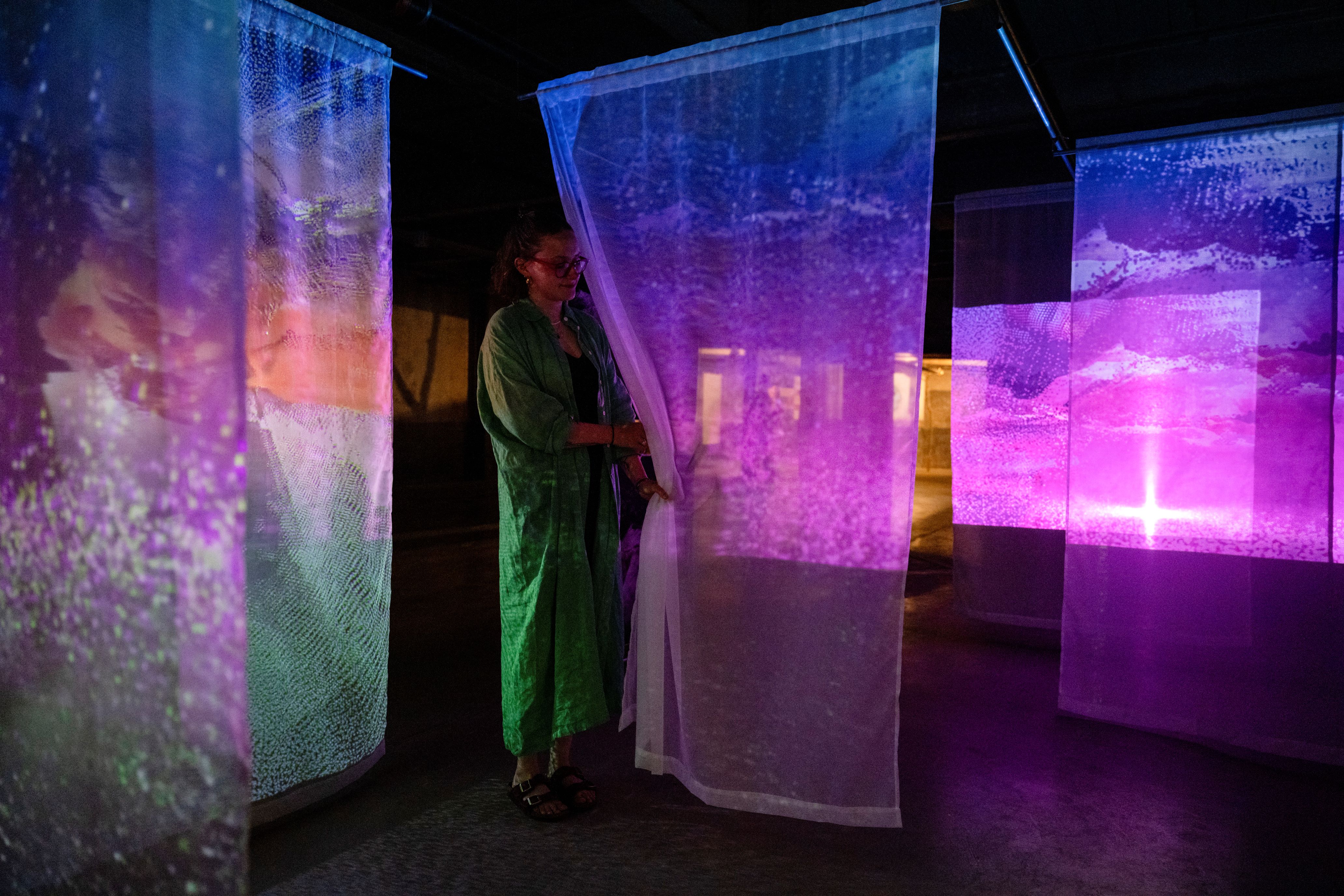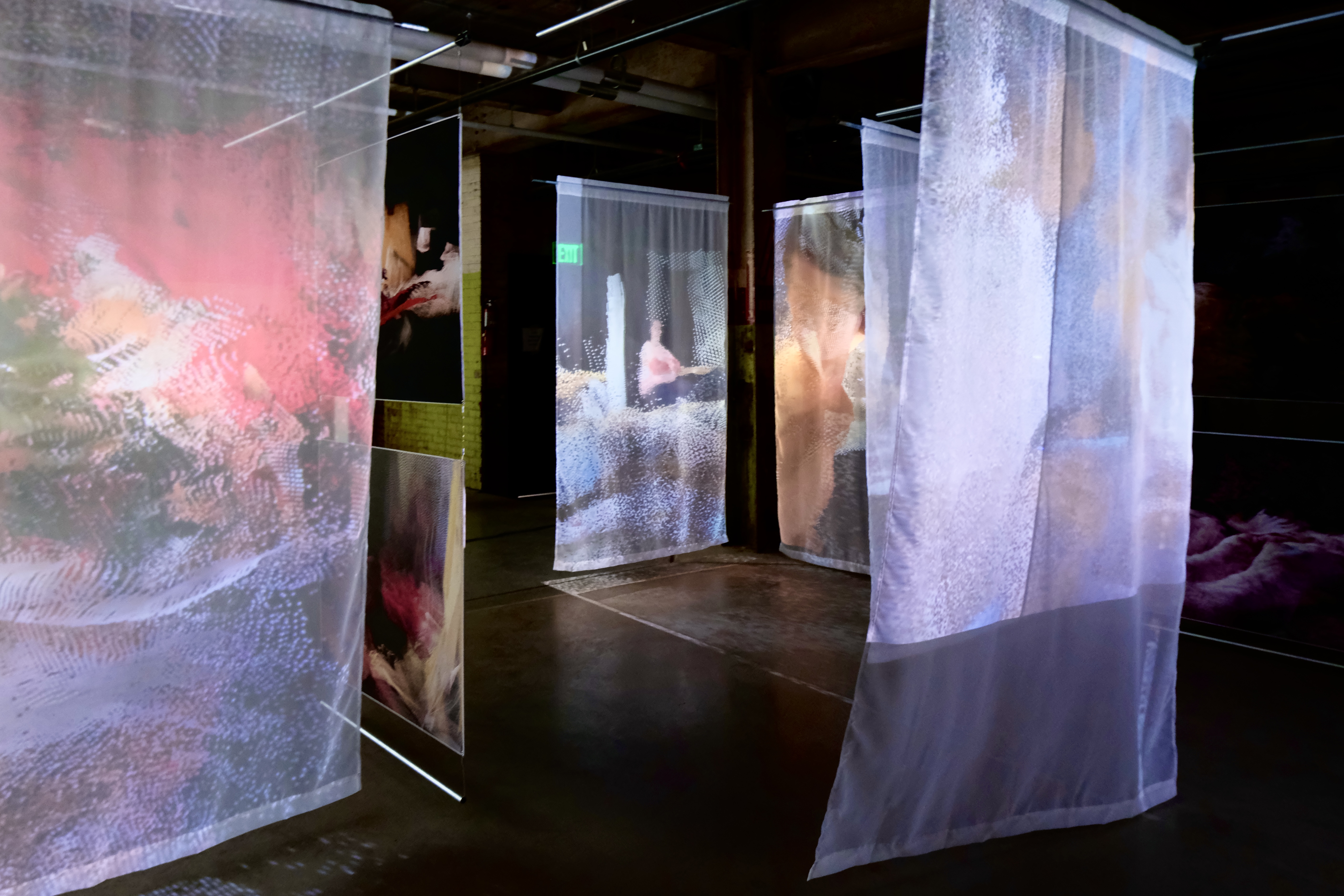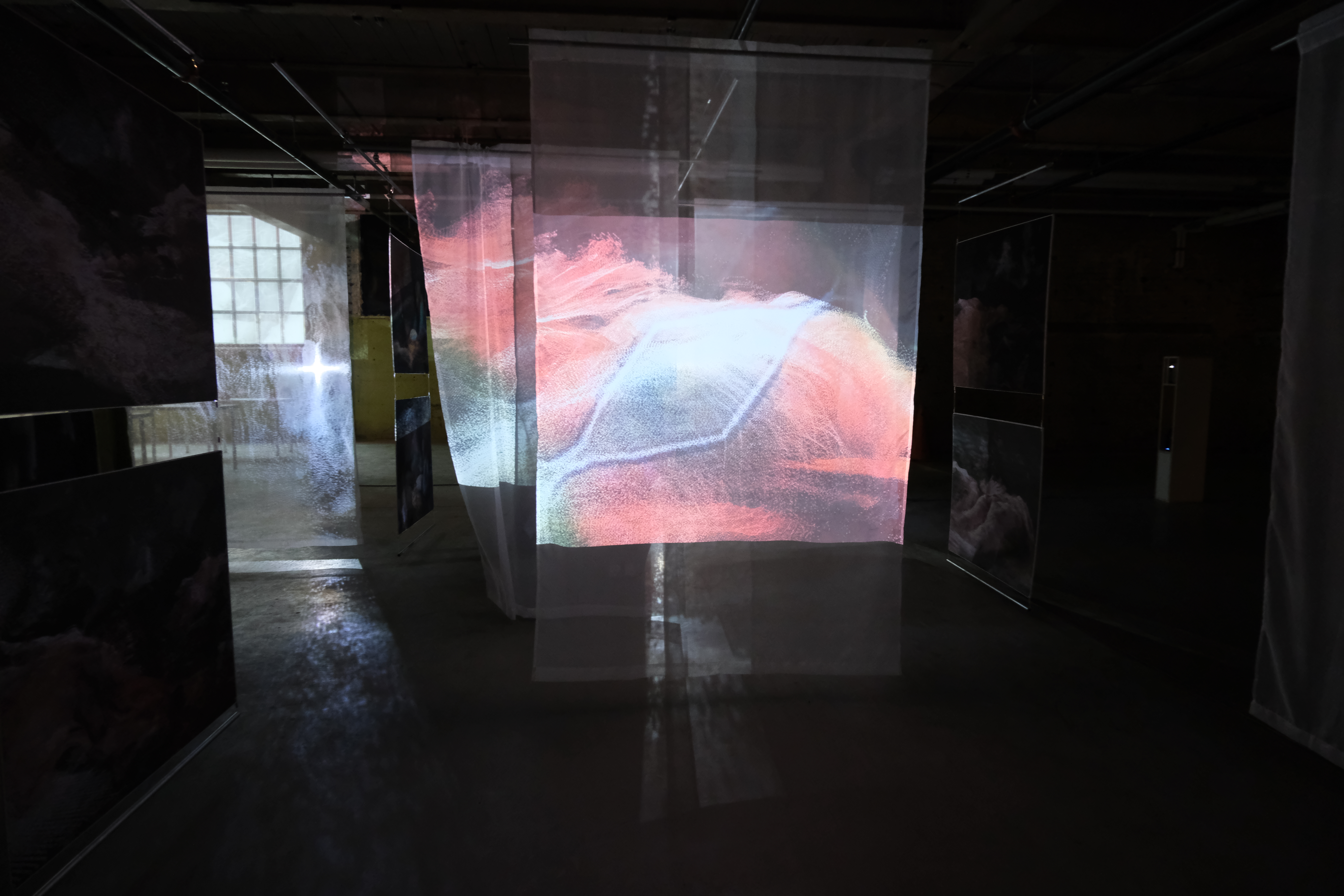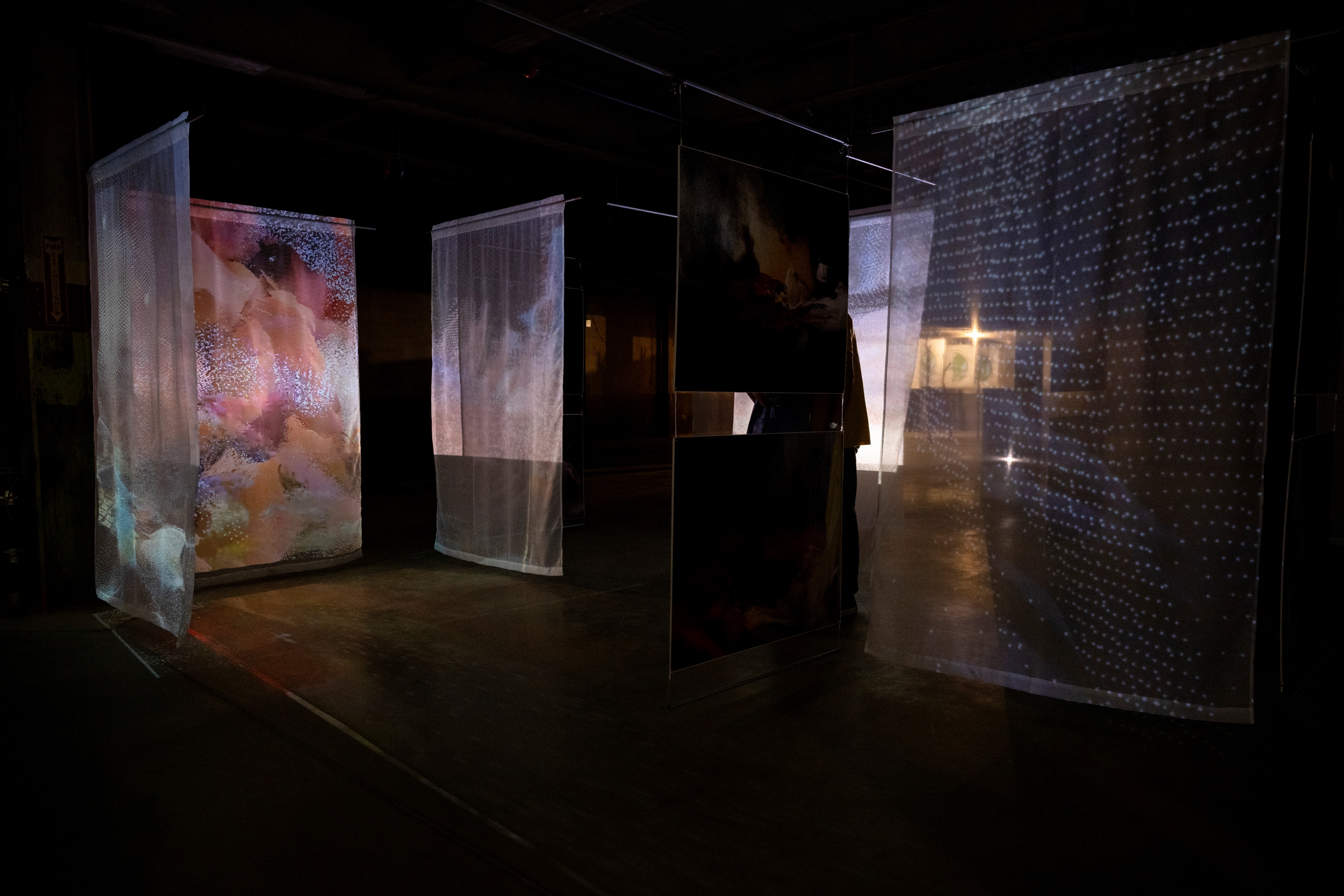the body at home:
textures of the architecturally everyday
textures of the architecturally everyday
CARNEGIE MELLON UNIVERSITY SCHOOL OF ARCHITECTURE / SPRING 2024 / BACHELOR OF ARCHITECTURE THESIS /
for the best experience press play while you scroll
Advisors: Mary-Lou Arscott + Heather Bizon
View Volume 1: Framing here.
View Volume 2: Stories here.
This work was featured in the final Carnegie Mellon School of Architecture exhibition, and debuted at Rockwell Park Gallery.
THE EXHIBITION




![]()
![]()
![]()
![]()
![]()
![]()
THE WRITING






For centuries, the discipline of architecture has concerned itself with the body. However, bodily explorations are limited to largely abstract representations. This thesis seeks to center the role of the experiential and the body as it impresses on, and is impressed upon by the built environment. I aim to capture textures and feelings through architectural methodologies in an effort to center the human domestic experience and shake the principles and understandings our discipline takes for granted.
There is so much variation in the ways that each body and the built environment react to one another–this collective uniqueness is, after all, what makes us human. In this way, no building is static. Architecture exists at the site of interaction between body and building; one cannot separate a building from the voices that bounce against its walls any more than one can separate a person’s life from how it has been shaped by architecture. It is the notion of a feedback loop that drives this thesis: where the body affects the built environment that in turn affects the body, repeated ad infinitum.
One ingress point to the interrogation of the human body within the built environment is the home. We spend much of our lives at home, brought to an extreme during the COVID-19 pandemic. Home is the place in which our most intimate relationships are investigated, where our mundane daily habits and creative work meet, where we hide our bodies from the outside world. The home itself is a complex organism made up of many parts which bleed into and over one another. Maggie Nelson describes the concept of a home as a combination of parts in The Argonauts: ‘It isn’t a penchant for decoration that differentiates [the way humans make homes]–it’s the compartmentalization of space. The way we cook and shit and work in different areas. We’ve done this forever, apparently.’ (Maggie Nelson, The Argonauts) At first glance, we might agree with Nelson, indeed almost every home across cultures shares the same ingredients: a kitchen, a bedroom, a bathroom, a living room. However, each of these considered and distinct components has the possibility for chimerism. The home is uniquely Queer in the way that we transform the “intended” function of each space: we eat in the bedroom, have sex in the bathroom, fight with family in the kitchen, and give presentations over zoom in the living room.
The home is also a location in which we collect the things we find important: everyday objects which might not intrinsically or societally have value but which are encoded with memories that we read like runes as they surround us. In Hanya Yanagihara’s A Little Life, these objects are described in relation to a lover recently lost: ‘Willem’s sweatpants, still slung over the edge of the laundry hamper; Willem’s toothbrush, still waiting in the glass on the bathroom sink; Willem’s watch, its face splintered from the accident, still sitting untouched on his nightstand–had become totemic.’ (Hanya Yanagihara, A Little Life) The reciprocity of interaction between space and body folds time back upon itself and calls back to memories embedded in physical artifacts and architectural materials. Our homes are haunted by the ghosts of our past, made physical and corporeal through the stuff we keep around. We choose these objects to surround us because it feels right, a phrase which Lorde describes as acknowledging: ‘The strength of the erotic into a true knowledge, for what that means is the first and most powerful guiding light toward any understanding.’ (Audre Lorde, Uses of the Erotic: The Erotic as Power)
In order to study how architecture and people relate to one another, one must consider the importance of the erotic and intimate. Spatial feedback loops concern not only the way that people and architecture interact with one another, but also how bodies impress upon each other, often within the context of the built environment. ‘It’s so dark, this underspace, dark and sweaty. His thin hair is damp, smells like candy and earth, I burrow my mouth into it and breathe.’ (Maggie Nelson, The Argonauts) We make meaning in this life by forming relationships with the people important to us, but also through interacting with the art and culture that moves us. In the words of Audre Lorde: ‘There is, for me, no difference between writing a good poem and moving into sunlight against the body of a woman I love.’ (Audre Lorde, Uses of the Erotic: The Erotic as Power)Morning light streaming through the windows, the sound of laughter bouncing off kitchen tile, the movement of body(ies) against linen sheets: these are the moments which are encoded in every space we inhabit. The uniting factor between architecture and human connection is the act of feeling something, of being impressed upon.
The home is secretive, erotic, everyday, liminal. It exists as a nexus of every interaction we have with the outside world, and is, as a result, in a state of constant flux. Elizabeth Grosz writes: ‘The space of the in-between is the locus of social, cultural, and natural transformations . . . where becoming, openness to futurity, outstrips the conservational impetus to retain cohesion and unity.’ (Elizabeth Grosz, Architecture from the Outside) It is in this way that the architecturally liminal actually has an incredible power–because it already exists beside the dreary binary: inside vs. outside. Not only this, but the home has the possibility for revolutionary action, occurring when its liminal nature allows radicality to leak to the outside. Maggie Nelson, in discussing A. L. Stein’s photographic installation Puppies and Babies (2012) reminds us of the power that everyday acts have to become revolutionary when considering their context. ‘Some of the subjects… may not identify as Queer, but it doesn’t matter: the installation queers them. By which I mean to say that it partakes in a long history of Queers constructing their own families–be they composed of peers or mentors or lovers or ex-lovers or children or non-human animals–and that it presents Queer family making as an umbrella category under which baby making might be a subset, rather than the other way around. It reminds us that any bodily experience can be made new and strange, that nothing we do in this life need have a lid crammed on it, that no one set of practices or relations has the monopoly on the so-called radical, or the so-called normative.’ (Maggie Nelson, The Argonauts) Like Puppies and Babies, this thesis aims to take something as normative and seemingly boring as the home and place it in a new light. By using analytical methodologies to investigate the body at home, it elucidates a reading of architectural discourse as a whole.
To contextualize my work within historical architectural discourse, I will offer a critique on modernism and functionalism as incomplete representations of the abstract body. Le Corbusier’s Modulor Man from 20th century modernism, Neufert’s Architect’s Data from the teachings of the Bauhaus, and Richard Dreyfuss’s Humanscale Manual from the period of early industrialization come to mind when thinking about the architectural relationship between the built environment and the body. These depictions of the supposedly constant proportions of an “average” body formed the basis for functionalism, prioritizing the organization of space in relationship to the ideal human form.
The “ideal” body as an architectural concept hails from designers known to be affiliated with naziism, classism, white supremacy, and misogyny, to name a few. These bigoted mindsets teach that one type of body is superior to all the rest. Quickly it becomes evident that the failures of Neufert, Le Corbusier, and Dreyfuss’s functionalist applications of the ideal body to architecture lies in their refusal to acknowledge that each human person is unique. The ideal body in this case becomes the abstraction, with the tangible and corporeal of bodily flesh reduced to something which can never be achieved. The neat dimension of 71 millimeters measured from the wrist to the center of the palm completely ignores how it feels when you hold that palm in your own.
With modernist titans often being the standard for “good design,” it is no wonder many architects today ignore just about every body that is not a white, affluent, able-bodied, cisgender, heterosexual man. Indeed, this fatal abstraction bleeds into architecture schools now when first-years forget scale figures in their section drawings, or an entire class’s perspectives end up populated with the same cut-outs from Nonscandinavia pulled quickly the night before final review.
Critiquing false universality in abstract representations of the human body is not new. One interrogation of functionalism as related to the body is the project L’homme, mesures de toutes choses (Man, measure of all things) by Thomas Carpentier, in which different and at times fantastical figures inhabit and influence works of architecture–Jabba the Hutt is hoisted through a home in a zipline-like contraption, Corb’s Modulor Man is edited to include a range of fantastical and diverse bodies including a wheelchair user, Neufert’s female proportion drawing is depicted with a bionic arm.
In lieu of these fantastical depictions, I am more interested in an expansion of the architectural discourse surrounding the body in the way that already occurs in the everyday. There is so much variation in the ways that each body and the built environment impress upon one another–this collective uniqueness is, after all, what makes us human. In this way, no building is static. Architecture exists at the site of interaction between body and building; one cannot separate a building from the voices that bounce against its walls any more than one can separate a person’s life from how it has been shaped by architecture.
It is the notion of a feedback loop that drives this thesis: where the body affects the built environment that in turn affects the body, repeated ad infinitum. But in terms of loops, circuits, and interactions, why is it that the most low-brow, often domestic architectures (a kitchen, a bedroom, a public restroom, a rest stop, a cafe) offer the most room for humanity, while the “well designed” architectural objects fall flat in this regard? Built works from the minds of modernist giants like Le Corbusier and Rem Koolhaas fail to acknowledge it is not the building that necessarily moves us, but the experience of it in the everyday.
Frank O’Hara’s identifies the schism between that which is respected by the academy and that which is meaningful: ‘just as at home I never think of the Nude Descending a Staircase or / at a rehearsal a single drawing of Leonardo or Michelangelo that used to wow me / and what good does all the research of the Impressionists do them / when they never got the right person to stand near the tree when the sun sank.’ (Frank O’Hara, Having a Coke With You) The iconic works of Duchamp, Michelangelo, and Monet are relatively meaningless without context. We are not moved by works of art in a vacuum, but rather because they dredge up memories of our passions. Architecture is the same; the discipline of making space is fundamentally useless if it ignores the ways in which we interact with each other within the context of the built environment. It doesn’t matter how well designed an architectural object is if it lacks capacity to foster the intimate moments that make us human.
Writer and activist Elio Choquette argues for ‘A ‘queering’ of architecture—a resistance to architecture as a tool of oppression and a re-appropriation of space as a tool of transformation. [This] is thus necessary for its transformative potential to be unleashed.’ (Elio Choquette, Queering Architecture: (Un)Making Places) The home as a Queer space has the potential to pose questions of inequality, ethics, and community that our discipline so desperately needs asked. Queerness as a transformative tool goes beyond a discussion of sexuality, pertaining rather to a reimagination of that which is ordinary, mundane, or everyday. This investigation does not define Queerness as simply homosexuality; rather this thesis takes a broader interest in that which is Queer, new, strange, or unusual. Interrogating the ordinary in a new context allows revolutionary possibility to leak in, and allows us to better appreciate the very fabric of our everyday lives as a radical practice of self-expression. This becomes incredibly important in a capitalist landscape which so readily attempts to nullify human connection for the sake of consumerism.
Lorde also expresses that: ‘the erotic functions… in providing the power which comes from sharing deeply any pursuit with another person. The sharing of joy, whether physical, emotional, psychic, or intellectual, forms a bridge between the sharers which can be the basis for understanding much of what is not shared between them, and lessens the threat of their difference.’ (Audre Lorde, Uses of the Erotic: The Erotic as Power) Sharing what makes us as humans feel is therefore paramount in the fight against bigotry and division. The pursuit of feeling stuff in our individual bodies is the thread that knits each of our unique experiences together into the collective tapestry of humanity.
This analysis deliberately features readings from both academic and purely narrative contexts. I feel the reading of low-brow, everyday works of architecture as essential to understanding the built environment necessitates the introduction of different kinds of writing. In the same way that perspectival or filmic representation provides the point of view of the human person within space, narrative writing can elucidate with higher clarity the senses and feelings that are crucial to understanding how people interact with spaces, and how these spaces in turn interact with people. This goes for representational methods, as well.
This thesis places the utmost importance on capturing the feeling of architecture, and therefore incorporates collage, photography, lidar scanning, and non-traditional modeling techniques in addition to more technical and typical drawing styles of plan, section, elevation. This thesis aims to capture the everyday while also demonstrating that it is, by definition, revolutionary, Queer, and sublime. Every moment exists in perpetuity regardless of whether it’s remembered. What has happened has happened; it occupies that moment in time forever. This thesis aims to calibrate the nexus between seduction and analysis, to provide a critical reading of the movement of the body in space while evoking the power of embedded memories.
Methodologies explored in this thesis combine video and soundscape, lidar scanning, photography, and collage to demonstrate the ways in which our bodies impress on the discipline of architecture, the built environment, and each other. Experimenting with strange confrontations of the body in space argues for a decentering of physical architectural spaces in favor of humanity.
A thesis focusing on the body is, by necessity, an architectural thesis. Critical race theory, queerness and gender studies, anti-colonialism and anti-capitalism must have a place in architectural discourse. This is not to say that architectural discourse must provide space for these theories; these theories already live within architectural discourse, whether it chooses to acknowledge them or not. We make architecture fundamentally for people, for the body; we invent places and spaces in which human connections are formed. Our discipline is inherently political, and it is time we started acting like it. Maggie Nelson frames the idea as one of “identitarianism,” stating eloquently: ‘Calling the speaker identitarian then serves as an efficient excuse not to listen to her, in which case the listener can resume his role as speaker. And then we can scamper off to yet another conference with a keynote by Jacques Ranciere, Alain Badiou, Slavoj Žižek, at which we can meditate on the Self and Other, grapple with radical difference, exalt the decisiveness of the Two, and shame the unsophisticated identitarians, all at the feet of yet another great white man pontificating from the podium, just as we’ve done for centuries.’ (Maggie Nelson, The Argonauts)
The discipline and academy of architecture often sideline or dispel conversations of labor, gender, sexuality, and class as “identitarian,” or extraneous to pure explorations of space; I argue that the challenges of the anthropocene necessitate the integration of these questions into every discussion of architecture. By observing spatial forces from these interdisciplinary lenses, architecture has the potential to ask and answer the questions of inequality, ethics, and community omnipresent in our epoch. This thesis centers the body at home in an attempt to capture what it is about architecture that is really important to the way we relate to one another.
‘I know we’re still here, who knows for how long, ablaze with our care, its ongoing song.’ (Maggie Nelson, The Argonauts)



︎︎︎residue . mise en scene ︎︎︎

















































































